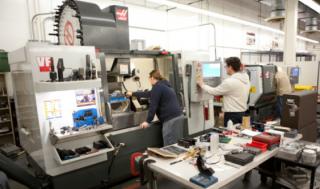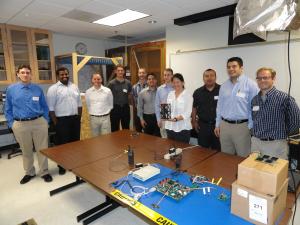Faculty: Advanced Materials Lab conducts advanced research
 Mix together one part biosensors, one part batteries and one part anticorrosive coatings, and what do you get? The college’s W.M. Keck Foundation Advanced Materials Lab.
Mix together one part biosensors, one part batteries and one part anticorrosive coatings, and what do you get? The college’s W.M. Keck Foundation Advanced Materials Lab.
For 18 years, the lab, under the direction of manufacturing systems engineering and management professor Behzad Bavarian, has been a hub of cutting-edge research in CECS, supported by the Keck Foundation, Easton Foundation, Department of Defense and NASA, among others. Currently it is focused on three projects—the aforementioned biosensors, batteries and anticorrosive coatings.
A couple of years ago, with funding from Medtronics and the university, Bavarian began investigating several protective polymer coatings for biosensors that would be implanted under the skin. The challenge was to find a material that would survive three months in the human body, which is a very unforgiving environment for foreign substances. Two of the coatings have now emerged as frontrunners, able to last 180 to 200 days of exposure.
The lab is also in the second year of a collaboration with a local company that has received National Science Foundation funding to explore the feasibility of creating metal ion batteries as an alternative to more expensive lithium ion batteries. Bavarian and his collaborators are focused on the potential of sodium and magnesium, two elements that are plentiful in the environment, and are hoping to develop batteries that are smaller and more efficient than those that are currently available. The project has attracted the interest of the Department of Defense, which wants to find alternatives to equip soldiers in the field, as well as the Department of Energy, which is looking for new energy storage solutions.
For five or six years, the lab has been working with the Cortec Corporation, to help develop a product that can be painted onto the surface of concrete and will penetrate deep inside to protect rebar against corrosion. The lab is compiling the data and has determined that it takes about 120 days to migrate into the structure and coat the rebar. The construction industry is also looking for long-term data, so Cortec wants to ascertain how long the coating will stay in place on the rebar. In addition, the lab has made suggestions to improve Cortec’s original formulation.
“The reason we selected these projects is because they require so much data acquisition, and it’s good practice for undergraduate students to get involved in the testing to learn how to conduct an experiment and be part of a team and communicate data,” Bavarian says. “This is promoting undergraduate research by motivating students to get involved in the earliest stage and contributing to these critical needs. It’s important to deliver results, but the bottom line is education and producing engineers who can begin to solve some of these critical needs.”
A message from the Dean
February 6, 2014Industry partnerships – HAAS
February 6, 2014Industry Partnerships – Jet Propulsion Laboratory
February 6, 2014
Leave a reply Cancel reply
-
A Laboratory for the Future
June 16, 2010 -
IAB Highlight Executive perspective benefits college
February 20, 2015 -
A message from the Dean
February 6, 2014




